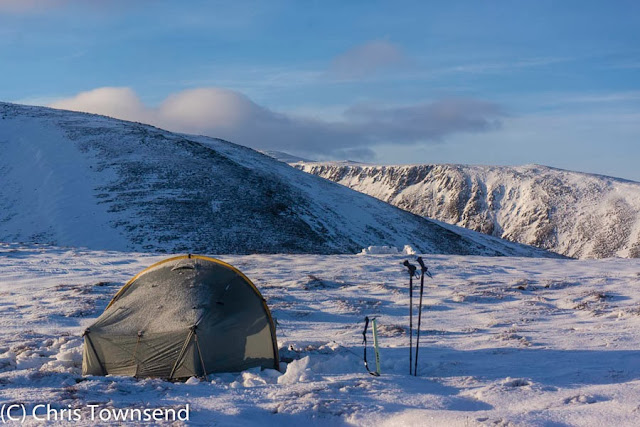 |
| Dawn |
With a thaw forecast a last venture out in the first big
snowfall of the winter seemed very attractive, especially as there looked like
being twenty-four hours or so of good weather. The idea of a snow camp, the
first for eight months, was also appealing. As I hadn't been up it yet this
year I decided to head for Bynack More, an outlier of the main Cairngorms
massif.
The walk began in pine woods still dotted with yellow-leaved
birch trees. Down here a thaw had already stripped away much of the snow,
leaving a complex dappled pattern of light and dark, snow and tree and heather.
Lochan Uaine was green with tree reflections. No ice yet. Beyond the trees the
snow cover slowly spread and deepened. Once the climbing really began it was
crunchy and unstable, sometimes supporting my foot, sometimes collapsing as I
put weight on it. High clouds kept the light flat and dull and there was only a
hint of pink in the western sky.
Above the long cleft of Strath Nethy I crossed the high moor
below Bynack More. Somewhere here I would camp. It's not a place I'd choose in
summer - the ground is either boggy or gravel and there's no water nearby. Snow
can be levelled for a flat bed and melted for water, opening up many places for
comfortable camps. This one I'd never used before and I was curious to know
what the dawn would bring as I pitched the tent as darkness fell.
 |
| Sunrise |
The evening was calm with the temperature just below
freezing. I fell asleep watching stars coming and going between the high
drifting clouds. Wet cold air brushing my face woke me hours later. A wind had
sprung up and was blowing spindrift into the tent. Although the middle of the
night it was lighter than when I'd gone to sleep. I looked out at a bright
half-moon and a starry sky. The clouds had gone with the wind.
 |
| A Comfortable Camp |
Hours more passed before I opened my eyes again. The light
had changed. The sky was turning from black to blue and a yellow-orange line on
the horizon spoke of the still-hidden sun. Bands of cloud again streaked the
sky. The temperature was -4°C. I lit the stove and lay in my sleeping bag
watching the sun rise over distant hills. The dawn was glorious. Reason enough
to be here in this wild and beautiful world.
 |
| Ben Avon from the ascent of Bynack More |
Leaving camp I headed up the long rocky north ridge of
Bynack More. No more than a walk in summer, with some optional easy scrambling,
it was rather more difficult covered with hard snow and rime ice. I stayed just
below the crest, out of the cutting wind. As the slope steepened I stopped to
put on crampons and swap a trekking pole for an ice axe. The going was easier
on the firm surface than on the breakable crusty snow below however and I was
soon on the windswept rocky summit looking out on the vast array of the
Cairngorms. The weather was already changing with the clouds thickening from
the west.
 |
| View from Bynack More |
Crampons biting securely into the shiny snow I crossed the
lower top of Bynack Beg and descended steeply into Strath Nethy. Flocks of
white ptarmigan flew low over the hillsides. As I neared the flat valley bottom
I was catching the crampons in heather as often as I was stamping them into snow.
Off with them. They were becoming hazardous. The River Nethy was low and easily
boulder-hopped. An arduous climb through more patchy snow and clinging heather
then it was a final skid down a steep little-used path through the woods. The
whole trip had only lasted twenty-four hours but I had been transported into
another more elemental world and the experience had been intense.
 |
| Strath Nethy |
 As it's time for Christmas gift buying here's a few suggestions from my work for lovers of mountains and wild places. The first one is the film I made with Terry Abraham earlier this year - The Cairngorms In Winter - which is available on DVD with some outtakes and other extras from some outdoor shops and from Striding Edge - see box to the right.
As it's time for Christmas gift buying here's a few suggestions from my work for lovers of mountains and wild places. The first one is the film I made with Terry Abraham earlier this year - The Cairngorms In Winter - which is available on DVD with some outtakes and other extras from some outdoor shops and from Striding Edge - see box to the right. For the Scottish hills as a whole, including the Cairngorms, there's my big Cicerone World Mountain Series book, Scotland. This is also full of pictures plus information on suggested walks, geology, natural history and more.
For the Scottish hills as a whole, including the Cairngorms, there's my big Cicerone World Mountain Series book, Scotland. This is also full of pictures plus information on suggested walks, geology, natural history and more.
.jpg)




































